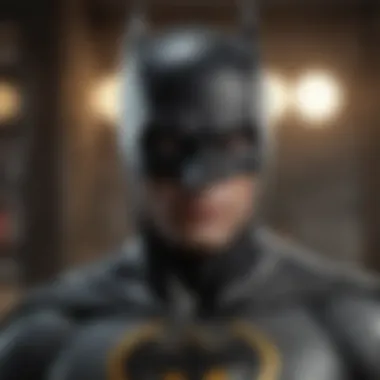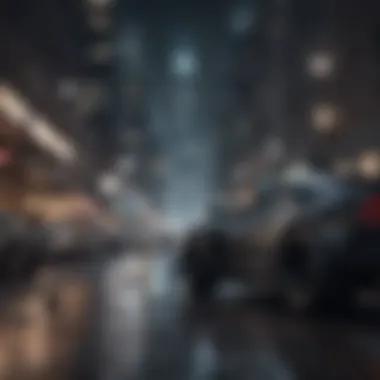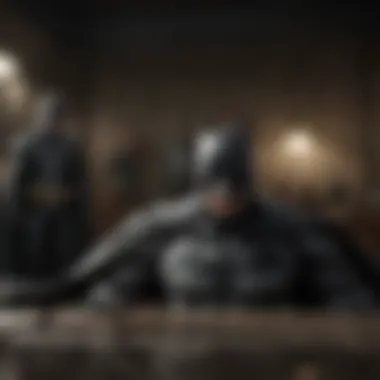The Evolution and Cultural Impact of Batman Unveiled


Intro
Batman, a figure synonymous with heroism, has transcended its initial comic book origins to engrave itself into the core of popular culture. The character, created by Bob Kane and Bill Finger, made his debut in 1939. Throughout the decades, Batman has undergone various transformations, reflecting societal changes and cultural shifts. In understanding the evolution and impact of Batman, one must appreciate not only his tales of crime-fighting but also the intricate psychology that lies behind the mask. This piece chronicles the significance of the Dark Knight, delving into his narrative complexity, character development, and how diverse adaptations continue to shape perceptions.
Overview of Batman
Since its conception, Batman initially appeared in Detective Comics, and later exploded into his own series. The Batman saga presents a man driven by a tragic past, focused on justice and vigilantism. Hollywood has embraced this character across various mediums including films, television shows, video games, and animated productions. Notable examples include Tim Burton's depiction in the late 1980s and Christopher Nolan's acclaimed Dark Knight trilogy. Each interpretation provides a glimpse into the audience's evolving expectations of heroism and moral ambiguity.
Plot/Storyline Analysis
Batman's narratives often revolve around his battles against iconic villains such as Joker, Riddler, and Catwoman. Each story reveals different facets to Gotham City amid crime and corruption.
Key aspects of several adaptations are explored in layers, where Batman often stands alone, grappling with moral dilemmas while confronting his adversaries. For instance, in The Dark Knight, the Joker serves as a moral foil challenging Batman's principles, forcing him to question what true justice means. This tension effectively engages the audience's reflections on ethics.
Character Development
At the heart of the Batman legacy lies Bruce Wayne, who embodies duality. His evolution showcases both heroism and vulnerability. Each character serves as a mirror, illuminating Batman's psyche.
- Bruce Wayne: Utilizes his fortune to combat injustice and quintessentially struggles with his identity.
- Alfred Pennyworth: Provides a paternal figure, contributing to Bruce's sense of morality.
- Joker: Represents chaos and often instigates fundamental questions about good vs evil.
Batman's interactions with these and many characters humanize him, allowing audiences to engage with his deep mental conflicts.
Visuals and Effects
The representation of Batman has captivated audiences visually for generations. Each medium has its visual style, which reinforces the character's ethos. From animated TV series embodying sharp lines and vivid colors to dark, moody cinematography in the modern films, these visuals greatly contribute to the storytelling.
- Cinematography: (The Dark Knight) uses shadows and atmosphere to enhance the ominous nature of Gotham as effectively depicting tense confrontations.
- Artwork: Comic books have offered diverse artistic interpretations, ranging from classic styles to contemporary designs, all uniting under the theme of stark moral battles.
Intro to Batman
Batman stands as one of the most significant figures in the realm of popular culture. His presence is felt in comics, films, television shows, and beyond. This section serves as the bedrock for understanding Batman's evolution, shedding light on his enduring appeal and influence over time.
The narrative surrounding Batman is multi-faceted. First, it is essential to situate his character in the historical context of his first appearance, providing insight into the societal landscape that birthed him. From the tumult of the late 1930s, the global environment shaped not just Gotham's vigilante but also American cultural values around heroism and justice.
Moreover, recognizing the creators, Bob Kane and Bill Finger, brings a deeper understanding to the character's complex origins. Their collaborative efforts established a foundation that would redefine what a superhero could be, particularly in the narrative depth and psychological development granted to Batman.
Understanding the introduction of Batman becomes significant in appreciating how he would inspire future narratives and characters in the superhero genre. This exploration will reveal not only the character's undeniable legacy but also the profound commentary on societal issues through his stories.
Historical Context of the First Appearance
Batman made his debut in Detective Comics #27 in 1939, emerging into a world poised for escapism yet grappling with reality. The late 1930s were marked by political turmoil and the looming shadows of World War II. As America sought figures of resistance against a backdrop of uncertainty, Batman presented himself as a dark and brooding character, starkly different from his predecessors like Superman and Captain America.
His introduction coincided with a growing interest in crime and detective narratives. People yearned for heroes who could confront urban chaos rather than simply fight aliens or supernatural foes. Thus, Batman triumphed in its appeal to both heroes and humanity's struggle against crime.
Creators Behind Batman: Bob Kane and Bill Finger
The birth of Batman is inextricably linked to his creators, Bob Kane and Bill Finger. Kane, with his artistic vision, designed the character, but Finger infused narrative depth into Batman's world and psyche. Notably, Finger contributed to the creation of key elements, including the iconic cape, cowl, and various supporting characters.
Their creative partnership was pivotal in shaping not only Batman but the entire superhero genre. The dynamic between Kane's visuals and Finger's storytelling grounded Batman in real-world issues, turning him into an enduring symbol of resilience.


Despite the achievements, the history of Kane and Finger’s collaboration also raised important questions about credit and acknowledgment in creative endeavors. Finger's contributions were largely overshadowed by Kane for decades, highlighting broader themes of acknowledgment that persist in creative industries today.
"Without the collaborative genius of Bob Kane and Bill Finger, we might not have experienced the multifaceted narrative richness of Batman’s world."
This reflection on their joint legacy sets the tone for understanding the resonant themes associated with Batman, paving the way for his various adaptations throughout the decades.
Character Development Through the Decades
The ongoing development of Batman as a character reflects the evolution of social attitudes, cultural expectations, and literary trends. Over the years, Batman has transformed from a relatively straightforward superhero into a complex yet relatable figure. This shift is not only significant for understanding Batman's journey but also for grasping how narratives evolve with their cultural contexts. The layers added to his character enrich the storytelling and enhance audience connection.
The Golden Age of Comics
Emerging in 1939, Batman's debut in Detective Comics No. 27 marked the beginning of the character's journey during the Golden Age of Comics. In this era, superheroes generally represented a moral archetype. Batman, created by Bob Kane and Bill Finger, emerged as a darker persona compared to other heroes of that time—his city, Gotham, was his playground, rife with crime and moral ambiguity.
Initially, Batman operated with relative simplicity. His primary battle centered on physical confrontations with criminals and gangsters. His gadgets and skills reflected the needs of audiences seeking escapism through action and adventure.
This initial portrayal laid the groundwork for future complexity, allowing writers to start exploring deeper themes of justice and morality. It also paved the way for pioneers of the medium, allowing Batman to embody different responsibilities and unbounded possibilities found in comic lore.
The Dark Age of Comics
The late 1970s and 1980s introduced the Dark Age of Comics. Here, Batman's character received a notable overhaul, notably through the keynote title Batman: The Dark Knight Returns by Frank Miller. This iteration presented a more tormented figure haunted by the past. The themes became darker; Gotham City portrayed as increasingly hopeless and altogether murky.
In this time, Batman's methods were more brutal, and his moral room for leniency shrank. Miller’s vision, along with works like Batman: Year One, helped redefine him, making Batman a detective and scrutinizing his duality more intensely. This reflection took on added meaning—confronting one’s inner demons resonated the mental struggles the comic book readership could relate to during that tumultuous period in history.
This transformation showcased how Batman's conscience was nessecary for establishing a reactive persona in relation to societal setbacks. The interplay of his alienation against the societal backdrop provided fertile ground for future explorations into darker psychological territories.
Modern Interpretations and Adaptations
The 1990s and beyond ushered in the era of modern adaptations, expanding Outreach across not only comic books but also into films, television series, and video games. With works from notably Batman: The Animated Series and films such as Christopher Nolan's The Dark Knight Trilogy, the complexity of Batman reached new heights.
These adaptations further explored his relationships with allies and foes, deepening moral dilemmas he faces. The animated series sort out depths within morals while maintaining a press of entertainment. Additionally, Nolan's trilogy resonates with real-world ethics and questions about power, failings, and human resilience. Thus, Batman became a vessel through which societal concerns could be examined.
Modern interpretations often depict him coping with trauma, loneliness, and ridiculously high stakes that resonate with viewers today, ensuring the relevance of the character. Notably, Batman embodies endurance and resilience for aspiring readers, encouraging analysis of humanity's flaws.
In summary, Batman’s character development throughout the decades signifies not only his rise in popular culture but also mirrors the prevailing social and psychological currents. It emphasizes shifts from clear-cut heroism to a more nuanced, imitative representation of human behavior, firmly embedding his cultural legacy in the narrative of superhero fiction.
Batman’s Psychological Complexity
Understanding Batman’s psychological complexity is crucial in fully appreciating the character's depth and longevity in popular culture. His persona embodies more than just the archetypal vigilante. The intricacies of his psyche reveal rich narratives surrounding trauma, morality, and duality, which resonate with audiences across generations. This complexity invites readers and viewers to ponder the implications of justice, vengeance, and identity.
The Trauma of Witnessing His Parents' Murder
The haunting event of Bruce Wayne witnessing the murder of his parents serves as the fundamental origin point for his transformation into Batman. This trauma profoundly shapes his character, instilling a conviction that emerges as a dual force of revenge and justice.
In psychological terms, this trauma breeds a myriad of conflicts within him. Bruce adopts the identity of Batman for two primary reasons: to fulfill an unshakable desire to right wrongs and to prevent others from sharing his tragic fate. This creates a relentless cycle of justice and pain, with each villain he encounters serving as a dark reminder of his loss. Their existences perpetuate his psychological unrest.
Moreover, users of pop culture often connect with Bruce's plight. The narrative invokes empathy and introspection regarding one’s own trauma and sense of loss. Therefore, the emotional and psychological intricacies serve to engage audiences at a more profound level, reflecting the universal nature of grief.
Batman's Duality: Bruce Wayne vs.


Batman
The dichotomy between Bruce Wayne and Batman showcases the multifaceted nature of his character. As Bruce, he embodies the façade of a wealthy playboy, disconnected from the darker realities of Gotham. Yet, this persona acts as a veneer that conceals his profound determination to fight crime and dispense justice as Batman.
This dissonance illustrates a tangible struggle, not only in handling the responsibilities of his role as a hero but also in maintaining his identity amid contrasting realities. Batman represents strict moral structuring; he battles crime with palpable intensity. Bruce Wayne, in contrast, often seems superficial—making it hard for the world to identify with his true mission.
The existential conflict here cannot be overlooked. Bruce often grapples with the implications of leading a double life. His existence inherently questions the nature of identity, victimhood, and moral inquiry. Can one genuinely generate change while fragmented between two fragmented lives?
In summary, exploring Batman’s psychological complexity reveals nuances of trauma and duality that reflect prominent human struggles. Batman remains relevant as a cultural figure, offering an avenue to discuss trauma, morality, and identity that resonates through different media, continually redefining the character for each generation.
Iconic Villains and Their Purpose
Batman’s universe is defined by its villains. Each character represents distinct facets of morality, chaos, and human psychology. Villains significantly affect the narrative and thematic expressions throughout Batman’s stories. They serve as critical components for examining conflicts between good and evil. Through their multifaceted portrayals, they provide insights into Batman's character while challenging his morals and ethics. Understanding these villains is key to grasping the overarching narrative and message in Batman narratives.
The Joker: Chaos Personified
The Joker is perhaps the most emblematic of Batman's foes. He embodies the concept of chaos, a force that stands in opposition to Batman's order and control. Introduced in 1940, the Joker has evolved from a whimsical character to a sinister embodiment of nihilism.
One significant aspect of the Joker is his unpredictable nature. He does not operate under a set of moral guidelines. Instead, his actions are driven by an innate desire to create disarray. This divergence from normality sets the stage for Destiny—the scene between Batman’s composed nature and the Joker’s erratic schemes emphasizes the vagaries of morality and justice.
Some dark narrative arcs, such as The Killing Joke, give this character profound depth. Here, while depicting the Joker’s origin story, the readers also see harrowing notions of perspective and mental illness.
“The Joker's unpredictability compels Batman to question his ideals and methods. In each encounter, he represents an existential dares to the Bat.”
In exploring the relationship between Batman and Joker, the narratives ponder deep psychological questions. The Joker forces Batman, and thereby society, to confront uncomfortable truths about their own beliefs in justice and order.
Harvey Dent: The Tragic Fall from Grace
Harvey Dent, originally represented as Gotham City’s District Attorney, is a tragic character exemplifying the risks associated with power and morality. Dent's journey from a 'white knight' upholder of justice to the disturbed entity known as Two-Face illustrates a fundamental conflict within Batman's universe—one's moral compass can easily become skewed over time.
His transformation happens when severe trauma fractures his personality and sense of justice, illuminating both fortitude and vulnerability within Gotham’s societal framework. This duality gives readers a sense of the fragility of the human psyche when faced with pain and betrayal.
Children of Gotham are taught the dark lesson that once purity corrupts, a descent into madness is often inevitable. The fall of Harvey Dent serves as a continuous theme warning against blind faith in order, while emphasizing the human beings can splinter into multiple versions of themselves.
Catwoman: The Anti-Heroine
Catwoman complicates the lines between right and wrong. As a character enriched with ambiguity, she often shifts from antagonist to ally. Selina Kyle operates in the grey areas of morality, symbolizing desires beyond mere criminality. This makes her both a foil and an essential partner to Batman within the wider narrative.
Her heists, unlike traditional villains, sometimes reveal altruistic undertones. Catwoman’s pursuit of wealth often intersects with her deeper, unspoken desire for connection—a complex motley tapestry of empowerment and fragility defines her arc. This exploration ensures that she is more than just an adversary; she serves as a mirror reflecting Batman's psychological conflict.
Catwoman’s relationship with Batman often plays with questions of justice versus consequence. Their interactions defy single categorization of good or evil. This is further explored, making viewers question their prejudices against the emotionally complex natures of anti-heroes.
Themes Explored in Batman Narratives
The narratives surrounding Batman have evolved deeply, examining complex themes that resonate with audiences. Understanding these themes isn’t just a scholarly exercise; it gives insight into societal values, anxieties, and aspirations. The character acts as a lens to explore larger questions about justice, morality, and the nature of heroism in a troubling world. When engaging with Batman’s stories, viewers and readers are called to consider the philosophical underpinnings that shape their understanding of right and wrong. This thematic richness significantly enhances Batman’s relevance in popular culture.
Justice and Vigilantism
The theme of justice is central to Batman's narrative. Batman embodies vigilantism but does so against a backdrop of chaos and moral ambiguity found in Gotham City. His commitment to justice goes beyond simple law enforcement. Unlike traditional heroes, Batman operates under a code, often raising crucial questions about the nature of justice itself.


- Vigilante Ethics: Batmans choice to operate outside the law illustrates the tension between following legal frameworks and seeking real justice. The character invites audiences to analyze whether it is acceptable to embrace vigilante actions:
- Does breaking the law make him a criminal?
- Or does it reflect a failure of the existing legal system?
- Impact on Society: Batman's emergence as a vigilante shatters the norms within Gotham. It reflects society's darker facets and raises uncomfortable truths. Sometimes systems fail the individuals they should protect. This failing can lead individuals to take justice into their own hands, leading to a spiral of moral complexity dicey about who the real villain is.
Batman's Cultural Impact
Batman’s presence extends well beyond the backdrop of comic books. His contributions shape societal perceptions and instigate discussions around complex themes within our culture. The impact of Batman is pervasive, influencing not only entertainment mediums but also institution than connotations of justice and morality that encounter society today. Moreover, from graphic novels to blockbuster films, the various representations illustrate cultural trends, audience expectations, and a growing dialogue around heroism.
Representation in Film and Television
From its early live-action iterations to contemporary cinematic masterpieces, Batman’s adaptation in film and television symbols a landmark of cultural influence. The character’s various portrayals, a mix of darkness and liberation, resonate with a wide audience, crossing generational and cultural lines. Kerwin Mathews, Adam West, and Christian Bale serve examples of how different approaches can elicit unique emotional responses and further expand narrative frameworks.
Over the years, several comodity makers develop television series focused purely on the lore of Gotham and its inhabitants. Shows such as Batman: The Animated Series play a pivotal role in deepening the character, introducing sophisticated storytelling devices while honing in on rich emotional undercurrents. Programs like Gotham delve into Dickensian attachments of characters, piecing together a glue that bonds every entity to a-brushstroke yet complex environment.
This blend of flavors in adaptation foregrounds shadow familiar characters; thus, Batman’s popularity fluctuations with societal tastes and tensions of respecting independence. Financial successes, alongside critical acclaim for properties like The Dark Knight, affirm the character's relevance and power in societal discourse. The representation fosters conversations around good, evil, and everything in-between, culminating in dialogues that shape our visual culture today.
Influence on Other Superhero Narratives
Batman's evolution has spurred a Pandora’s box of implications, paving paths for a myriad of other superhero narratives. Notably, the darker utilitarian approach allows for flexibility, challenging the typical tropes of heroism. A generation of upcoming superheroes has synthesized Batman’s moral and philosophical complexities, allowing for re-imagination.
Superhero films and shows that followed began mirroring the themes Batman embodied—robust villains, complicated backstories, ethical dilemmas, and impactful societal commentary. For instance, characters like Deadpool and Taskmaster showcase a self-aware heroism making fun of their motifs—an evolution stemming from the foundation laid by Batman. A sense of vulnerability has become core to developing iconic figures, compelling storytellers to embody abrasive realism.
Equally, inexperienced vigilantes, as seen in Spider-Man and Daredevil, echo Batman's source of intrinsic agony, recognizing that a hero’s prowl transcends passing throes. Other narratives contain annotations from Batman's brood, sustaining trauma while resisting the straightforward dichotomies of good versus evil.
Batman has opened floodgates to character arcs forcing us to ponder choices—the deeper veins in heroism mapped by inner turmoil.
In summation, Batman stands as a staggering figure, dramatically materializing narratives extending throughout visual mediums and extending rich insights into popular culture's heartbeat.
Finale: The Enduring Legacy of Batman
Batman’s journey from the pages of comic books to the big screen reflects a deep, evolving narrative resonating with diverse audiences. The enduring legacy of this character is not merely about superhuman feats or escapism; it prompts critical reflections on morality, justice, and identity. Overall, this article has explored key elements that contribute to the fascination with Batman. Understanding Batman goes beyond his portrayal; it examines how he captures the struggles of humanity. His character can be seen as both a heroic figure and a deeply flawed individual, which renders him relatable to many.
In exploring Batman’s continuing relevance in popular culture, it becomes evident that his complex narratives influence countless interpretations.
Continuing Relevance in Popular Culture
The cultural significance of Batman persists strongly in today’s society. Films like The Dark Knight trilogy by Christopher Nolan explored the darker facets of the character, reflecting contemporary societal anxieties. These movies not only captivated audiences through action but also invoked discussions surrounding ethical nuance and the line between heroism and vigilantism.
Furthermore, animated series and video games have introduced Batman to newer generations. Projects like Batman: Arkham Asylum articulate the psychological aspects of his character, enlightening players on the nuances of his dual identity as Bruce Wayne and Batman. Likewise, television series such as Batman: The Animated Series have set benchmarks in storytelling of superhero narratives. Critical response underscores Batman’s rich thematic content as mainstream media continue to explore socio-political themes and psychological complexity.
"Batman symbolized more than a superhero; he embodies the ongoing strife between good and evil in society."
When evaluating Batman's cultural impact, one must recognize how he serves as a conduit for viewers to unpack their fears. From day-to-day struggles to larger global issues, the character facilitates open dialogue around pressing matters.
Anticipating the Future of Batman
The future of Batman looks bright yet uncertain. With various adaptations in development, there lies potential for both innovative storytelling and the risk of overexposure.
Recent explorations bring forth gritty reimaginings such as Matt Reeves' The Batman, aimed at peeling back the layers to address new societal context, all the while drenched in noir aesthetics. The narrative juxtaposes the hero’s challenges with contemporary moral dilemmas society presents today.
Moreover, as technology evolves, new platforms emerge for storytelling. Augmented reality and virtual gaming set the stage for unique and interactive designs involving Batman’s world, captivating audiences in unimagined ways.
By integrating timeless themes with innovative approaches, Batman remains vital for those familiar with his mythos and craving modern interpretations. In this evolving landscape, the discussion shifts back to resilience, representation, and relevance, ensuring Batman’s legacy carries forward into the future.
The rich tapestry of narratives surrounding him guarantees that he will continue to be a subject of analysis for both cultural critics and audiences alike. This suggests that Batman, beyond being just a fictional character, remains a relevant medium through which many can make sense of the complexities of life and morality.















